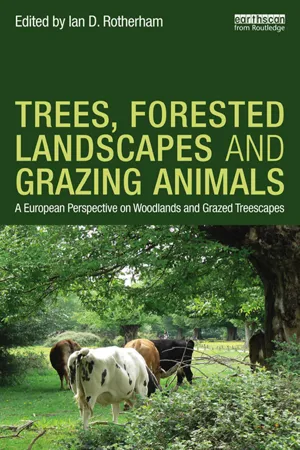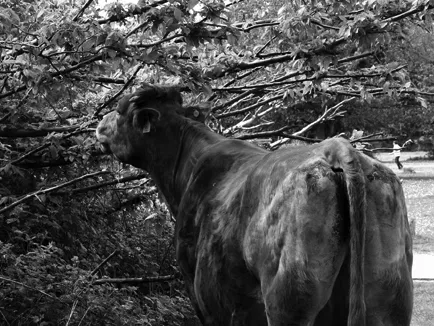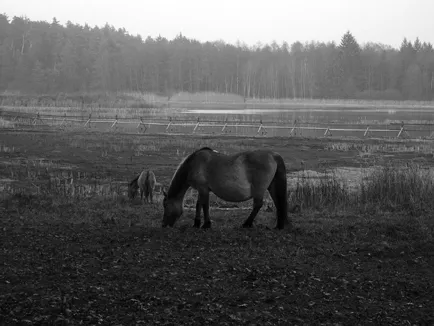![]()
Part I
Grazed treed landscapes
![]()
1 Grazed treed landscapes
Overview and introduction
Ian D. Rotherham
Introduction
The ongoing debates and discussions around the ‘Vera hypothesis’ of the origins of north-western European landscapes (Vera, 2000) have stimulated academics and others to view the evidence afresh (e.g. Hodder et al., 2005; Hodder and Bullock, 2009; Mitchell, 2005; Whitehouse and Smith, 2010). The issues and research outputs have been considered at a series of major international conferences held in Sheffield, UK; the most recent of these being ‘Animals, Man and Treescapes’ held in September 2011. The outputs from the meetings have been published (see Rotherham and Green, this volume) and the debates have contributed to raising awareness of the subjects and to developing new research paradigms (Green, this volume). In particular, it seems worthwhile to attempt to place the ideas of Vera's hypothesis (Vera, 2000) into a framework of historic timelines of wooded environments and to consider its relationship to the cultural landscapes from medieval times onwards. A key issue to emerge is the existence historically of populations of ‘working trees’ mostly in open-grown and in open ‘wooded’ or ‘treed’ landscapes.
It is argued here, that the origination of these trees was driven and powered by the ecology of large grazing herbivores (prehistorically and historically) and I would add by the economy of large grazing herbivores too (historically).
Developing the research paradigms
Academics and practitioners alike have been considering the roles of grazing and browsing by large mammalian herbivores in European wooded landscapes of various sorts. One issue to arise from discussions has been what do we recognise as ‘woodland’ and following from this, how can we evaluate the roles of grazing and browsing animals in these environments — now and in the past. Scholars such as Peterken (1981 and 1996) have addressed the development and dynamics of wooded landscapes from perspectives of both site history and ecology. In terms of the impacts of large herbivores, a natural starting point is to consider known and obviously grazed landscapes with trees and then work back in time to assess their histories and their relationships to other ecological systems and communities. Another approach, which in large part stimulated Vera's own original observations, is to examine presently grazed sites and to interrogate the ecological and landscape implications of grazing impacts. Researchers have noted how ancient parks, originating in medieval or earlier times, provide unique insights into the once great primeval savannahs across much of north-western Europe. Certainly, their remarkable biodiversities provide evidence of such potential lineage. These landscapes present palimpsests of ecology and archaeology that reflect their economically driven origins over 800–1,200 years. Indeed, Since Oliver Rackham's seminal works Ancient Woodland (1980) and The History of the Countryside (1986), it has been accepted that wood-pasture was once the most abundant type of wooded landscape in north-western Europe. In essence, wood-pasture is a system of land management where trees are grown and grazing by large herbivores (domesticated, semi-domesticated, wild or a combination of stock) is permitted. Wood-pasture in England is well documented for over a thousand years, and the Domesday Book (1086) probably records a landscape dominated by the practice. It has been suggested that wood-pasture was an ancient system of management that developed in a multi-functional landscape where woodland was plentiful and where there was little need for formal coppice. The latter is a more intensive and rigorously managed system, intended to ensure vital supplies of wood and timber in a resourcelimited landscape (Fowler, 2002; Hayman, 2003; Muir, 2005; Perlin, 1989). The conservation value and importance of pasture woods and of veteran trees was first raised for many people by the work of Harding and Rose in the 1980s (Harding and Rose, 1986). Site-specific studies (e.g. Harding and Wall, 2000) have further confirmed the significance. Pasture-woodland is the older system and in many ways more ‘natural’. Significantly, most livestock, wild or domesticated, take leaf fodder or browse if offered (Figure 1.1). This is in preference to grazing (Vera, 2000). These systems of land management, their ecologies and economics, were described by Rotherham (2007a and b). This volume presents recent research that seeks to embed the Vera ideas within a framework of historic cultural ecology (Rotherham, 2011a), and the broader topic of European grazed, wooded landscapes is considered through key contributions by scholars and practitioners from a diversity of academic and professional backgrounds and experiences.
There is considerable interest in the idea of either ‘ancient’ woods or ‘old growth’ forest (e.g. Peterken, 1981 and 1996; Rackham, 1976, 1978, 1980, 1986 and 2004) and in relating this to contemporary management. However, many such approaches to wooded landscapes are fundamentally flawed by the absence of an understanding of the historic context of the sites and of their ecologies, or by hands-on practitioner observations of contemporary site management. This volume brings together key works to
Figure 1.1 Cattle grazing and browsing parkland
Source: Ian D. Rotherham
help close the knowledge gap. Recent research in the UK and across Europe seeks to address these issues and to provide a robust interrogation of forest and woodland dynamics that can better inform contemporary management and conservation. This book develops ideas as the evidence base for these assertions. Rotherham (2011a) and Rotherham and Wright (2011) provide models into which historical and ecological information can be placed to assess critically the issues of woodland antiquity and ecological continuity. These help form a useful framework for analysis. These studies also seek to integrate problems of cultural severance (Rotherham, 2008, 2011b) in wooded landscapes. They address the potential for both dynamic change in ecology and the contradictions of long-term spatial stability too. The Woodland Heritage Manual (Rotherham et al., 2008) was a major step towards a more integrated approach to the study of wooded landscapes.
Emerging ideas and concepts
The progress reported so far represents an attempt to reconcile to ideas of scholars such as Frans Vera (2000), of an open savannah-like primeval landscape in Europe, with mediaeval and contemporary woodland in countries such as England. Vera's work suggests that large herbivores, browsing and grazing, were drivers in a landscape that mixed successional woodland, big open-grown trees and expansive grasslands or heaths. In attempting to weld the ideas of primeval grazed landscapes to pre-enclosure medieval Europe, the contribution of historians is important. A key idea to emerge from these studies in England, for example, is that of the Act of Commons or Statute of Merton representing watershed in the spatial fixing of ‘woods’ in their landscape context (Rotherham, 2011a). These named woods are today marked out and identifiable by so-called botanical indicators. Examples to test the ideas were taken from wooded landscapes in England in order to relate known historic timelines to demonstrable changes in ecology, in woodland structure and in pedology (Rotherham, 2011a). The methodology described (Rotherham, 2011a) helps to facilitate an improved understanding of woodland landscape history but it also informs future management and conservation strategies for forest and woodland areas. It also attempts to place wooded landscapes in a wider context of historically grazed ecosystems.
There is still a debate about the nature of this primeval landscape across north-western Europe and this has stimulated cross-disciplinary collaborations to help focus on core evidence-based assessments. To some extent too, these studies have helped to at least provide an idea of what is agreed by most experts and also where there a still areas of dispute and disagreement (e.g. Hodder et al., 2005; Hodder and Bullock, 2009; Mitchell, 2005; Whitehouse and Smith, 2010). The discussions centred on the seminal work of Frans Vera (2000) have helped to clarify how the early landscape might have looked and perhaps aid the understanding of how their biodiversity relates to that which we see today (Hodder et al., 2005; Hodder and Bullock, 2009; Rackham, this volume). Our vision now is not one of wall-to-wall forest, but of plains or savannah that are more open with a rich diversity of other landscape and ecological components too and patches (some very extensive) of more dense closed forest. Much of this variation would be related to basic environmental factors such as climate and waterlogging, but the key factor identified by Vera is the importance alongside these of large grazing herbivores (Figure 1.2). Not everyone agrees with Vera's hypothesis, but the argument is compelling and a refined version of his original vision has a considerable body of supporting evidence (Vera, this volume). Issues of upland/lowland variation and interactions also need to be built into the Vera ideas and these were discussed at the meetings held in Sheffield in 2005 and 2007 (Rotherham, 2005 and 2007c).
A wetter landscape
I suggest that the European landscape had vast expanses of wetland, marsh, fen and peat bog with extensive coastal wetlands too. Over large areas of shallow, wet landscape it is likely that grazing herbivores were ecological
Figure 1.2 Konik ponies grazing in Poland
Source: Ian D. Rotherham
keystone species. Unfortunately, most of the studies so far, in addressing the broader issues of interpretation of palaeoecological or palynological evidence, have rarely considered landscape history specifically. This omission means that some of the interpretations from the rigorous scientific analysis are lacking in their wider applicability. There are attempts now to redress this shortcoming (e.g. Samojlik et al., in prep.). The impacts of widespread and catastrophic drainage across much of the European landscape, an...


